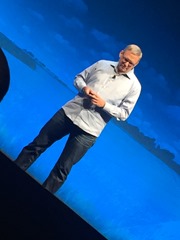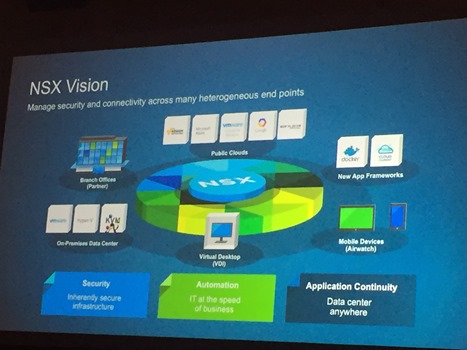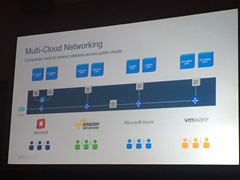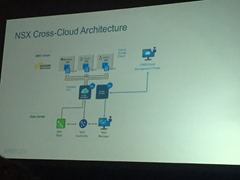VMworld US 2016 Buzz: NSX – The Network Bridge to the Multi-cloud Future – NET9989-S
Adding some more colour to the highlights from my VMworld US 2016 coverage:
- VMworld US 2016: The Day 0 Buzz
- VMworld US 2016: The Day 1 Buzz
- VMworld US 2016: The Day 2 Buzz
- VMworld US 2016: The Day 3 Buzz
- VMworld US 2016: The Day 4 Buzz
 I then attended a session to expand on the Day 1 announcements around NSX connecting multiple clouds together.
I then attended a session to expand on the Day 1 announcements around NSX connecting multiple clouds together.
The session was run by VMware Chief Technology Strategy Officer, Guido Appenzeller and customer Isao Eguchi from Nomura Research Institute.
The session went through how networking is changing to support tomorrow’s applications, multiple hypervisors, multiple clouds, multiple platform architectures. Guido mentioned the first change is the software independence from hardware. He used the analogy of the PC which had a motherboard from Dell, CPU from Intel and OS from Microsoft. This hasn’t happened in networking until now. Network virtualisation is part of this disaggregation by being able to run software in the hypervisor.
The second change is the evolution of the application, applications today run as distributed systems. He went through the sales pitch that you still need a hypervisor for containers.
The future for NSX is connecting public and private clouds and running traditional and cloud native applications.
Scott Lowe did three great live demos showing creating NSX networks created from within Kubernetes with pods and firewall rules based on tags specified in a YAML file. Then native Docker with NSX networks created by Docker commands. This uses a Docker network driver which then interprets the command and hands off the network provisioning to NSX. Lastly a demo with Pivotal Cloud Foundry, also creating NSX networks from within PCF.
I really think these demos should have had more focus in the keynotes, the keynote showed a web GUI with pretty pictures but that’s certainly not how developers are approaching cloud native apps which is very much automation and hence command line driven. I know VMware at this show is trying to show it can be the grown up infrastructure to support these new containers but I think they’ve swung the pendulum too far in looking just at the back-end ops view and need to still show how the native developer experience is still the same. That’s the power of cloud native and vSphere, standard developer view but transposed on the back end to be enterprise compliant/secure/manageable etc.
Guido then went on to expand on the morning keynote which is cloud networking. He showed how AWS and on-prem vSphere is linked together. There is an agent required which runs within the AWS instance which runs a small vSwitch which does the NSX magic.
NSX Manager, Controller and Edge can either be all on-premises or in a VMware Cloud which is the NSX SaaS management. I like the idea of infrastructure management from the cloud, NSX will have it soon, can’t wait for vCenter and vRealize.
This does however mean the NSX story for the multi-cloud world is very much at an infrastructure layer as you need to manage an EC2/Azure VM and install the NSX driver. This isn’t then containers running natively on AWS secured by NSX as was the previous demo with Docker/Kubernetes/PCF on prem. I’m not sure whether this AWS/Azure VM could then be a proxy into the rest of AWS so sort of form a NSX AWS edge device onto cloud services.
I like the developing NSX workflow story for DevOps, allowing developers to use native tools and doing the network magic on the back-end. This means you can encode your corporate network policies centrally and have a consistent view across clouds.
VMworld2016 has made the recording of many sessions publicly available but not this one it seems.





Recent Comments